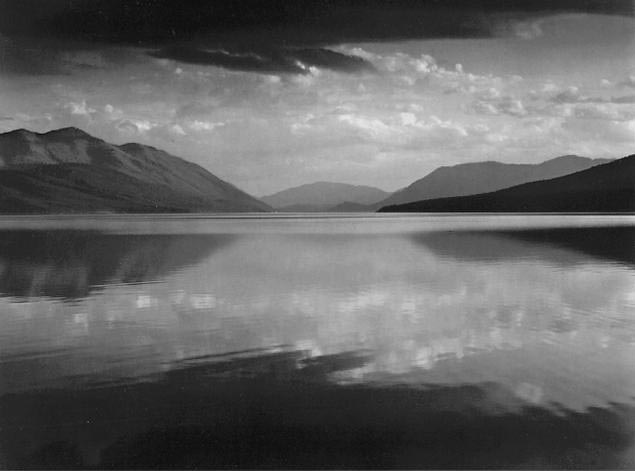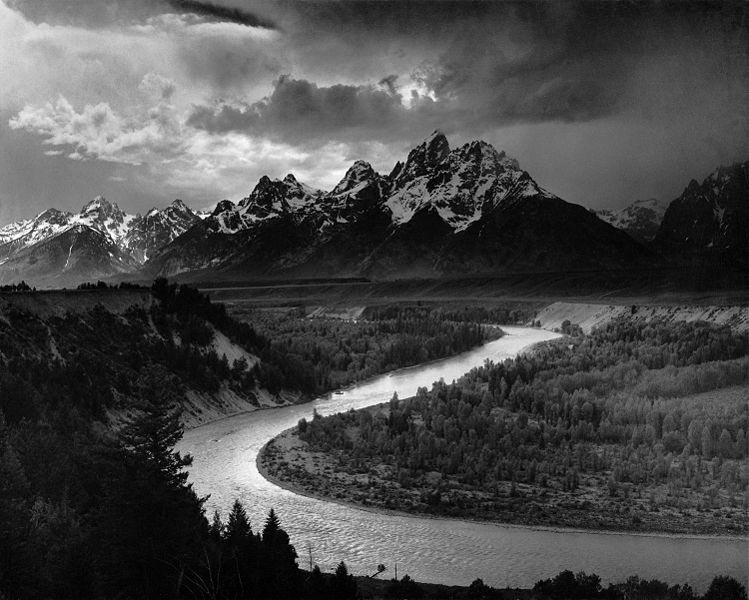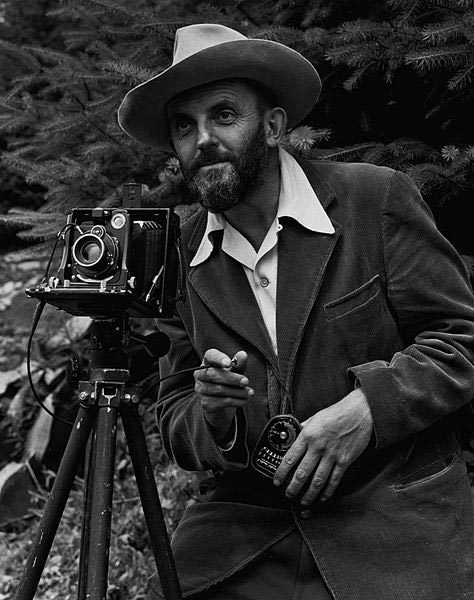Ansel Adams, (February 20, 1902 – April 22, 1984) was born in San Francisco, California, to a businessman, Charles Hitchcock Adams and Olive Bray. Coming from a privileged family, he spent most of his childhood in a home close to the Golden Gate. Unfortunately, in 1907, the Adams suffered a grave financial setback which his father struggled to resurface from. Adam was raised in a conservative Victorian setting – both socially and emotionally. This was mainly due to the fact that he was an only child of two elderly parents, his mother almost in her forties, and also because of the influence of his mother’s unmarried sister. The financial misfortune that his family had been experiencing had placed his mother in such frustration that it had affected her son deeply. On the other hand, his father, still hopeful to restore their once great financial status, gave his son the much needed support, hope and encouragement every boy deserves.
His days in school were no field trip either since he was believed to be hyperactive and dyslexic. His poor performance in school had left his father and aunt to have him home schooled instead. In time, he was able to receive a “legitimizing diploma” from the Mrs. Kate M. Wilkins Private School which is similar to having accomplished the eighth grade today.
 During those trying times of his growing up, he was able to find solitude in nature by taking strolls near the Golden Gate and appreciating the sand dunes, Lobos Creek and Baker Beach. As a substitute for formal schooling he taught himself to play the piano and thus became his profession for several years. It was where he found structure and discipline in his once unruly life. Ultimately he gave up the love for music for photography. He has particularly fond of the Yosemite Sierra and spent countless hours visiting the area until his death. He used a Kodak No. 1 Box Brownie, a present from his parents, to capture the beauty of the scenery. He became a member of the Sierra Club, which was essential for his success early in his career. He became its Lodge’s “keeper” for several summers. This is where he met his wife, Virginia Best, whom he married in 1928 and who bore him two children.
During those trying times of his growing up, he was able to find solitude in nature by taking strolls near the Golden Gate and appreciating the sand dunes, Lobos Creek and Baker Beach. As a substitute for formal schooling he taught himself to play the piano and thus became his profession for several years. It was where he found structure and discipline in his once unruly life. Ultimately he gave up the love for music for photography. He has particularly fond of the Yosemite Sierra and spent countless hours visiting the area until his death. He used a Kodak No. 1 Box Brownie, a present from his parents, to capture the beauty of the scenery. He became a member of the Sierra Club, which was essential for his success early in his career. He became its Lodge’s “keeper” for several summers. This is where he met his wife, Virginia Best, whom he married in 1928 and who bore him two children.
Parmelian Prints of the High Sierras, was his first portfolio acquired in 1927. Contained within this portfolio are some of his famous works of art such as Monolith and the Face of Half Dome. He used his Korona view camera with glass plates and a dark red filter to capture these images. The dark red filter was used in order to heighten the tonal contrasts of the image. During the trip where he took these photos, he only had one plate left and Adams was said to have visualized the outcome with the darkened sky before even having done the shot. He said that he already had a particular image in mind and it was not how it appeared but as how it would have felt. After his first exhibit, made possible with the help of Albert Bender, he made approximately $3,900. He then joined the Roxburge Club which was dedicated to appreciating photography, particularly fine printing and excellent standards. Hence, he was able to develop his skill in printing techniques, design, ink types and layout which can be seen in his later works.
 In his 60-year career, the 1930’s was one of his most prolific and adventurous times. He centered on broadening his genre by doing detailed close-ups of landscapes such as mountains and city skylines. He was able to make his first solo exhibit in the Smithsonian Institution in 1931 which showcased 60 photos he took in the High Sierra. After a successful review from the Washington Post, he was determined to yet again expand his genre by including still life. He used techniques such as long exposures to natural light and utilizing small apertures in order to produce sharp and widely focused images such as the Rose and Driftwood of 1933. He formed Group f/64, which promoted the use of straight photography against pictorialism. Their ideals were composed of producing photographs that followed more of the techniques of painting rather than modern photography. This posed a concern since several techniques such as “soft focus” lenses were deemed unacceptable. He attempted to have his own gallery but he did not succeed and it eventually became the Danysh Gallery.
In his 60-year career, the 1930’s was one of his most prolific and adventurous times. He centered on broadening his genre by doing detailed close-ups of landscapes such as mountains and city skylines. He was able to make his first solo exhibit in the Smithsonian Institution in 1931 which showcased 60 photos he took in the High Sierra. After a successful review from the Washington Post, he was determined to yet again expand his genre by including still life. He used techniques such as long exposures to natural light and utilizing small apertures in order to produce sharp and widely focused images such as the Rose and Driftwood of 1933. He formed Group f/64, which promoted the use of straight photography against pictorialism. Their ideals were composed of producing photographs that followed more of the techniques of painting rather than modern photography. This posed a concern since several techniques such as “soft focus” lenses were deemed unacceptable. He attempted to have his own gallery but he did not succeed and it eventually became the Danysh Gallery.
 In 1938 he created a limited-edition book, Sierra Nevada: The John Muir Trail, as part of his clubs efforts to institutionalize Sequoia and Kings Canyon into National Parks. He was named the editor of the U.S. Camera, which was the most popular magazine in photography during the 1930’s. In his later years, he also produced a photography show entitled, A Pageant of Photography that was attended by millions. Also he taught at the Art Center School of Los Angeles that included the training of military photographers. He produced one of his most famous works, Moonrise. Moonrise was shot in New Mexico and was first shown in the Museum of Modern Art in 1944. He was able to sell the original prints of the image summing up to $25,000,000. By the 1950’s his creativity seemed to be at an all time low. He became a consultant for the Polaroid Corporation that was founded by his friend, Edwin Land. He was able to recover when he had an exhibition at the Metropolitan Museum of Art.
In 1938 he created a limited-edition book, Sierra Nevada: The John Muir Trail, as part of his clubs efforts to institutionalize Sequoia and Kings Canyon into National Parks. He was named the editor of the U.S. Camera, which was the most popular magazine in photography during the 1930’s. In his later years, he also produced a photography show entitled, A Pageant of Photography that was attended by millions. Also he taught at the Art Center School of Los Angeles that included the training of military photographers. He produced one of his most famous works, Moonrise. Moonrise was shot in New Mexico and was first shown in the Museum of Modern Art in 1944. He was able to sell the original prints of the image summing up to $25,000,000. By the 1950’s his creativity seemed to be at an all time low. He became a consultant for the Polaroid Corporation that was founded by his friend, Edwin Land. He was able to recover when he had an exhibition at the Metropolitan Museum of Art.
Adams had contributed a lot to both the world of photography and to the environment. His passion for both helped to make the society around him realize his cause. And because of these, he received numerous awards such the Conservation Service Awarded given by the Department of Interior, a Presidential Medal of Freedom and the Sierra Club John Muir Award while he also received a Doctorate Degree in Art from Harvard and Yale Universities. For his continued support of nature, a 11,760-foot peak in the Minarets Wilderness and Inyo National Forest was renamed as the Ansel Adams Wilderness and Mount Ansel Adams respectively. He was able to achieve all these awards in his 60 years in the profession. Though he had a lot of struggles during his earlier years, he proved that it was not too late to turn his luck around.
